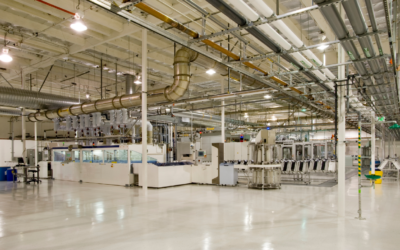The waiting room is often the first impression patients have of your facility, so maintaining a clean space is critical. Beyo nd creating a good impression, cleanliness helps reduce the spread of bacteria and viruses, a significant concern in healthcare environments. With numerous people passing through daily, germs can spread quickly if surfaces are not regularly sanitized. Cleanliness also helps your medical office stay compliant with health regulations from organizations such as OSHA and the CDC.
In this article, we’ll explore practical cleaning and maintenance tips specifically tailored for medical office waiting rooms, ensuring that your space remains both welcoming and safe for patients.
Essential Cleaning Supplies for Medical Waiting Rooms
When cleaning a medical office waiting room, the products you use matter. To effectively disinfect and sanitize, it’s important to select EPA-registered cleaning agents that are proven to eliminate bacteria and viruses. Here’s a list of essential supplies:
- Hospital-grade disinfectants
- Microfiber cloths for efficient dusting and cleaning
- HEPA-filter vacuums for capturing airborne particles
- Disposable gloves, masks, and aprons to protect cleaning staff
- Eco-friendly, non-toxic cleaning agents for patient safety
Using the right products is key to ensuring a clean, safe environment without exposing patients or staff to harmful chemicals.
Daily Cleaning Checklist for Medical Waiting Rooms
Keeping a medical waiting room clean requires consistent daily maintenance. Here’s a daily checklist to ensure nothing is overlooked:
- Disinfect all high-touch surfaces, including doorknobs, chairs, reception desks, and magazines.
- Empty and sanitize trash cans regularly to prevent overflow.
- Sweep and mop floors with a disinfectant solution, paying special attention to high-traffic areas.
- Wipe down furniture and electronic devices in the reception area.
Performing these tasks daily ensures that your waiting room remains presentable and hygienic, reducing the risk of contamination.
Deep Cleaning Procedures to Prevent Germ Spread
While daily cleaning is essential, medical waiting rooms also require periodic deep cleaning to address areas that are harder to sanitize during regular maintenance. Deep cleaning procedures help prevent the buildup of germs and bacteria, keeping the environment safe for patients and staff.
Deep cleaning steps include:
- Thoroughly disinfecting carpets, rugs, and upholstered furniture using steam cleaning or appropriate sanitizing solutions.
- Cleaning and sanitizing curtains or blinds, which can harbor dust and allergens.
- Changing air filters and servicing HVAC systems to maintain air quality and reduce airborne pathogens.
- Disinfecting baseboards, vents, and hard-to-reach corners that are often overlooked during routine cleaning.
Professional cleaning services like Complete Cleaning Company specialize in these deep cleaning techniques, ensuring your waiting room remains not only visually clean but also germ-free.
Cleaning Techniques for High-Touch Surfaces
In medical office waiting rooms, high-touch surfaces are hotbeds for contamination. These surfaces include door handles, light switches, reception desks, and shared items like pens or tablets. Keeping these areas sanitized can significantly reduce the spread of infections.
Here are some effective cleaning techniques for high-touch areas:
- Use disinfectant wipes or sprays approved for healthcare settings to sanitize surfaces multiple times throughout the day.
- Minimize shared items such as magazines or toys, or ensure they are disinfected between uses.
- Consider adding protective covers on frequently touched surfaces that can be wiped down easily.
Frequent sanitization of these high-contact points is essential, especially during cold and flu season. A commercial cleaning service like Complete Cleaning Company can provide scheduled cleaning routines that focus on these critical areas.
Waiting Room Furniture Maintenance
Medical waiting rooms are often furnished with various materials, from leather to fabric and plastic. Maintaining these materials is important not only for cleanliness but also for prolonging their lifespan. Different types of furniture require different cleaning methods to ensure they stay in good condition:
- Leather Furniture: Use a mild soap and water solution to wipe down leather chairs and sofas. Avoid harsh chemicals that can damage the leather. Condition the leather regularly to prevent cracking.
- Fabric Furniture: For fabric seating, use a vacuum with an upholstery attachment to remove dust and debris. Spot-clean stains with an appropriate cleaner and consider using a steam cleaner for deeper sanitization.
- Plastic Furniture: Plastic seating is easy to clean with a disinfectant spray. Wipe it down regularly to prevent the buildup of grime.
Regular inspection of furniture ensures it remains both functional and appealing. Complete Cleaning Company offers maintenance services that keep your waiting room furniture in top condition, maintaining a clean and professional appearance.
Handling Spills and Stains in Medical Waiting Rooms
Spills and stains are unavoidable in any high-traffic area, including medical waiting rooms. Quick and effective management of these incidents is important to maintain cleanliness and prevent lasting damage. Here’s how to handle them:
- Immediately blot liquid spills using paper towels or a clean cloth to absorb the moisture.
- Use appropriate cleaning agents to treat stains based on the type of spill (e.g., coffee, blood, or other bodily fluids).
- For biohazard spills, cleaning staff should wear PPE and use disinfectants that meet healthcare standards to ensure safety.
Quick response to spills helps maintain a professional and sanitary environment. Professional services like Complete Cleaning Company can also assist with difficult stain removal and biohazard clean-up.
Best Practices for Disinfecting Electronic Devices
Electronic devices, such as tablets, phones, and kiosks, are frequently touched but can often be overlooked during cleaning. These devices need to be disinfected regularly to avoid spreading germs:
- Turn off devices before cleaning to prevent damage.
- Use disinfectant wipes or alcohol-based cleaning solutions designed for electronics.
- Focus on areas frequently touched, such as screens, keyboards, and buttons.
Maintaining a Clean and Inviting Atmosphere
A clean waiting room should also be inviting to create a welcoming atmosphere for patients. Here’s how to maintain both cleanliness and comfort:
- Ensure furniture is arranged neatly and cleaned regularly to enhance the room’s aesthetic appeal.
- Freshen the air with non-toxic air fresheners or ensure proper ventilation by regularly opening windows or using air purifiers.
- Replace old magazines, brochures, and toys with new, easily sanitized items or use disposable materials.
These efforts contribute to a more inviting and professional environment, reassuring patients that cleanliness is a top priority.
Importance of Proper Waste Management in Medical Facilities
Proper waste disposal is crucial in medical settings, especially with the potential for biohazardous waste. Here’s how to manage it effectively:
- Ensure waste bins are emptied frequently, especially those containing medical waste, such as used masks and gloves.
- Use touch-free bins to reduce cross-contamination.
- Regularly disinfect trash cans, especially those in high-traffic areas.
Scheduling Regular Professional Cleaning Services
While daily cleaning by staff is important, hiring professional cleaning services ensures deeper, more comprehensive sanitation. Regularly scheduled cleaning services can address areas that are harder to maintain with daily tasks, such as carpet cleaning, high windows, and air ducts.
For medical office waiting rooms, it’s recommended to schedule professional cleaning at least once a week, or more frequently depending on the volume of traffic. Complete Cleaning Company offers specialized cleaning services.
Implementing a Cleaning Rotation Plan for Staff
One way to ensure that cleaning tasks are not overlooked is to establish a cleaning rotation plan for your staff. By dividing responsibilities, you can maintain high standards of cleanliness without overburdening any one person.
Here’s how to create an effective cleaning plan:
- Train staff on proper cleaning protocols and safe handling of disinfectants.
- Assign different cleaning tasks to staff members on a rotating basis.
- Create daily and weekly checklists to ensure all areas are consistently maintained.
Organizing cleaning responsibilities ensures every aspect of the waiting room is cared for regularly. For specialized or large-scale cleaning needs, Complete Cleaning Company is available to support your efforts.
Compliance with Health Regulations and Standards
Medical facilities are required to adhere to strict health regulations, including those set by OSHA and the CDC. Ensuring that your cleaning practices align with these standards helps reduce risks and avoid legal issues. Some important steps include:
- Ensure that all cleaning products meet healthcare standards, such as using EPA-registered disinfectants.
- Keep updated on changing health regulations to ensure compliance at all times.
- Maintain detailed logs of cleaning procedures to provide evidence of compliance during health inspections.
By following these guidelines, you can maintain a safe and compliant environment. Complete Cleaning Company offers cleaning services that follow all health regulations, ensuring your medical office meets the highest standards.
Eco-Friendly Cleaning Practices for Medical Offices
While maintaining cleanliness is critical in medical environments, it’s also important to consider the environmental impact of cleaning products. Many offices are opting for green cleaning solutions that are both effective and environmentally friendly.
- Use biodegradable and non-toxic cleaning agents to reduce the impact on both patients and the environment.
- Switch to energy-efficient cleaning equipment that reduces energy consumption.
- Ensure proper ventilation to improve indoor air quality without relying on chemical air fresheners.
Eco-friendly cleaning practices not only benefit the environment but also promote a healthier space for patients and staff. Complete Cleaning Company offers green cleaning solutions for medical offices looking to reduce their environmental footprint.
Conclusion
Maintaining a clean and well-organized medical office waiting room is critical for patient safety, regulatory compliance, and a positive patient experience. By following these cleaning and maintenance tips, you can ensure that your waiting room remains a welcoming, hygienic space for all visitors. For comprehensive cleaning services that meet the unique needs of medical offices, Complete Cleaning Company is your trusted partner, providing expert solutions to keep your waiting room spotless and compliant with health regulations.
FAQs
- How often should medical office waiting rooms be deep cleaned?
Medical waiting rooms should undergo a deep cleaning at least once a week, depending on the amount of foot traffic. More frequent cleanings may be necessary during peak seasons, such as flu season. - What cleaning products are safe for use in medical office waiting rooms?
It is best to use EPA-registered disinfectants and hospital-grade cleaning solutions. If possible, opt for eco-friendly, non-toxic cleaning agents to ensure patient safety. - Can staff handle waiting room cleaning, or should it be outsourced?
While staff can manage daily cleaning tasks, it is recommended to hire a professional cleaning service, such as Complete Cleaning Company, to ensure thorough, compliant, and effective sanitation. - How can we reduce the spread of germs in medical waiting rooms?
Frequently clean high-touch surfaces, provide hand sanitizer stations, and use touch-free technology where possible to minimize contact. Regular professional cleaning will also help reduce germs. - Are green cleaning products effective for medical offices?
Yes, many green cleaning products are highly effective and meet healthcare standards for disinfecting. These products reduce the environmental impact while maintaining a high level of cleanliness.



